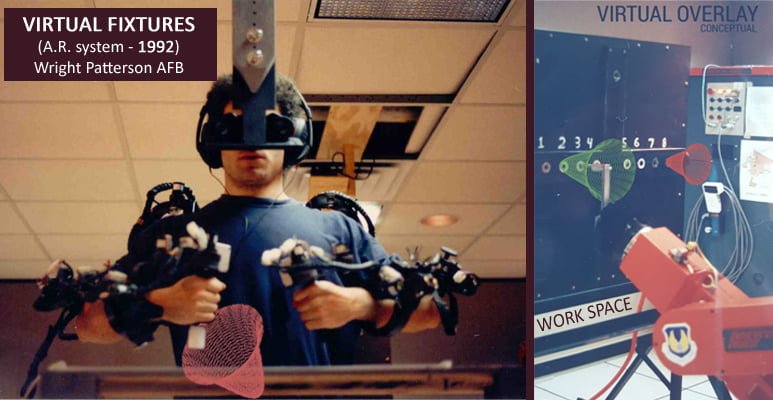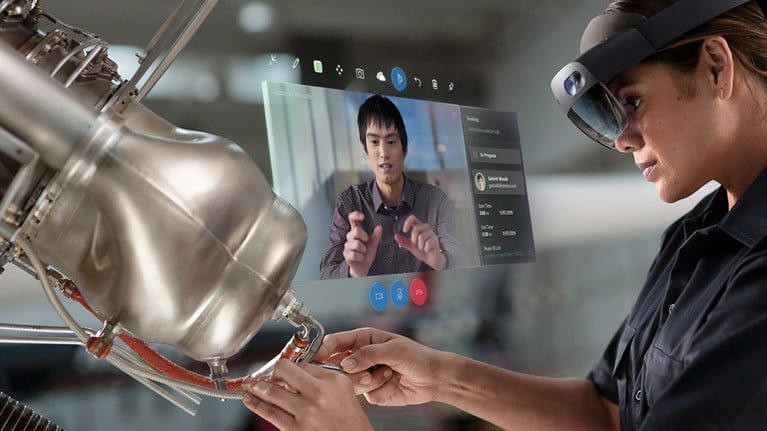Augmented reality technology witnessed many breakthroughs throughout history until it gained the traction it has today. Without further ado, here are the major turning points in the history of overlaying computer-generated information onto the real world.
History of early research on augmented reality
Computer scientists, artists, and researchers ushered in the era of augmented reality before the technology companies followed in their footsteps.
Sensorama: the first example that augments an experience
Today, we differentiate AR from the adjacent technology known as virtual reality (VR). But, at the very beginning, there was no distinction.
We can start the early beginnings of AR with Sensorama because it was the first example of a multisensory addition to a virtual experience. It simulated a ride with visuals, smell, sound, and movement. Sensorama was invented by cinematographer Morton Heilig in 1957 and patented in 1962.
Sword of Damocles: the first head-mounted display that overlays virtual information
Computer scientist Ivan Sutherland made the first head-mounted display known as the Sword of Damocles in 1968. The display, named after the Greek legend, included computer graphics that placed virtual information over the user’s physical environment.
Videoplace creates the first interface that lets users interact with their surroundings
The Videoplace interface, built by the computer artist Myron Krueger in the 1970s and 80s, allowed users to interact with virtual objects for the first time. Krueger referred to his invention as the “artificial reality” and built a dedicated laboratory for it.
Thomas Caudell coins the term augmented reality for the first time.
Boeing researcher Thomas Caudell coined the term augmented reality in 1990 while doing a project on head-mounted displays employees could wear for assembling aircraft components.
Virtual fixtures: the first immersive AR system
Louis Rosenberg developed an immersive AR system, virtual fixtures, in 1992 at the US Air Force’s Research Lab. The system relied on two physical robots controlled by the user. The virtual overlays added physical barriers to the environment while the user was performing real-life tasks. The objective was to train military personnel on controlling machinery.
These early attempts mainly served research purposes and military applications. After ARToolkit, ARQuake, and technology giants like Google and Microsoft entered the scene, AR began to gain mass appeal.

ARToolkit paves the way for mass adoption by providing developers with an open-source kit.
Hirokazu Kato developed the open-source AR development kit in late 1999/early 2000. Today, it’s still kept open-source and hosted on GitHub. It’s a library to develop augmented reality applications based on video tracking capabilities.
ARQuake: the first outdoor AR game
Developed by Bruce H. Thomas in 2000, ARQuake is the augmented reality version of the popular game Quake. Built on a first-person perspective, the game allows users to play outside in the physical world. Players can see the monsters at their virtual locations and shoot at them using real-life props.

Tech giants enter the scene.
Google Glass
Google released the prototype of Google Glass in 2013, a pair of voice-commanded smart glasses. It displayed information to the user with a head-mounted device. The consumer side of the project was eventually upended, but Google Glass, despite the backlash at the time, gained a secure place in the history of augmented reality. Today, the research continues for enterprise applications.
Microsoft HoloLens
Released in 2015, Microsoft Hololens is an augmented reality headset that is actually a wearable computer that runs on Windows 10. It allows browsing the web and scanning the surroundings. It can be used for experiences that blend with the real world; many real-life use cases include mixed-reality applications in enterprise settings such as health care, staff training, and manufacturing.
Spectacles
Spectacles are Snap’s take on smart glasses. They were initially produced in 2016. Their primary focus is to empower creators and innovators so they can push the limits of creating AR experiences.
Reimagining the road to immersive experiences
If you’re new to the AR arena and eager to learn more about how the technology fits in with the metaverse and web3, we invite you also to read:
- Three ways to show your NFTs in AR.
- The definition of immersive NFTs.
- How AR enables geo search in the metaverse.
Author

Nagi An is a content writer who is passionate about NFTs, web3, DAOs, and DeFi. She's covers a variety of topics about NFT fundamentals.




